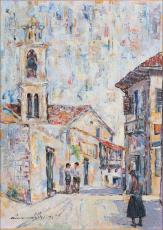


This oil painting was made ten years after Card Players (see pp. 96 -97) and reveals certain new stylistic tendencies on the part of the artist. With his intentions still focused on the play of light and colours, Victor Ioannides used his medium in a completely different way. Using a spatula and a thick paint brush, he applied the colour to the painting’s surface in a downward direction, in dense layers. Dominating the work is the colour white, which ‘converses’ with all the other colours and defines the tremendous brightness of the composition. The painter gives the impression that he created this riot of colours by breaking down the colour white into all the colours that combine to produce it. In this painting, Ioannides transcended the natural colours of this particular view, to serve a colour perception of his own, conveying to the viewer a pleasant, happy mood.
It is clear that the subject matter itself was not of particular importance to the artist: while depicting a typical Cypriot village, with its church and traditional buildings, he focused on the play of light, which, through a technique which was new to him, he tried to capture on the painting surface. Human presence, albeit discreet, lends life and movement to the built landscape.
He studied at the Athens School of Fine Arts, under Georgios Iacovides, Spyridon Vikatos and Nikolaos Lytras. During his studies, he worked as cartoonist in the newspapers Eleftheros Typos (Free Press) (1923-1924) and Elliniki (Greek) (1925-1929) and as an illustrator for the Great Greek Encyclopedia. In 1930 he returned to Limassol and in 1936 he founded with G. Fasoulioti the first workshop in Cyprus that delt with design and advertising, called Atelie. The pair also issued the satirical newspaper To Gelio (The Laughter) (1936-1937). Additionally, he worked as an art teacher in secondary education (1931-1933, 1942-1965). Thematically, his art focuses on landscape, and scenes from everyday life featuring the rural and urban communities. He also painted portraits, still lifes and nudes. He was concerned with capturing visual reality, and depicted his themes with an impressionistic and realistic approach. His personal style is characterized by his skilled draftsmanship and often simplified, free approach to his subjects, perhaps due to his work as a cartoonist. He was particularly interested in technique and spent a great deal of time researching and testing materials, particularly tempera and varnish, in order to achieve the ideal translucency and brightness of colour.